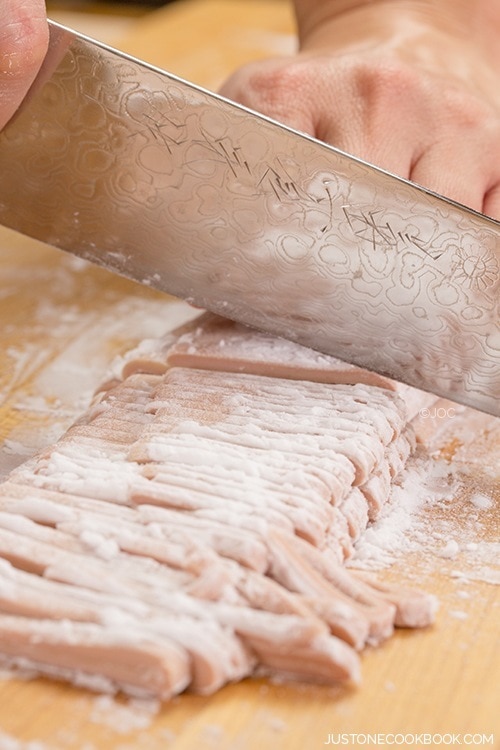Learn how to make udon noodles from scratch. You’d be surprised how easy & fun it is once
you give this homemade recipe a try! With a little bit of footwork (yes, read on to find out more), you’ll get some delicious homemade noodles that is far more superior than store-bought ones.
 https://www.justonecookbook.com/udon-noodles/
https://www.justonecookbook.com/udon-noodles/
you give this homemade recipe a try! With a little bit of footwork (yes, read on to find out more), you’ll get some delicious homemade noodles that is far more superior than store-bought ones.
Udon Noodles

Ingredients
For regular white udon
- 200 g all-purpose flour (200 g = 7 oz)
- 90 g water (90 g = 90 ml)
- 10 g Kosher salt (10 g = about 2¼ tsp)
- potato/corn starch (or flour for rolling and dusting)
For pink udon
- 200 g all-purpose flour (200 g = 7 oz)
- 80 g water (80 g = 80 ml)
- 10 g Kosher salt (10 g = about 2¼ tsp)
- potato/corn starch (or flour for rolling and dusting)
- 10 g beet juice (10 g = 10 ml) (or about 2 tsp)
For Beet Juice
- 1 beet
- 1 cup water
Instructions
- Gather all the ingredients. If you are making white udon, skip to step 5.
- Peel and slice the beet root into ½” (1.3 cm) thickness.
- Put sliced beets and 1 cup of water in a small saucepan and cook for about 20 minutes until the beet juice is reduced to about 2 Tbsp.
- Save the beet juice in a small bowl. Combine 80 g (80 ml) water and 2 tsp. of beet juice. Add the 2 ¼ tsp. salt and mix until it’s completely dissolved.
- Combine 90 g (90 ml) water and 2 ¼ tsp. salt and mix until it’s completely dissolved.
- Place the flour in a large bowl and add the salted beet juice (for pink udon) or salted water (for regular udon) little by little while mixing with hands.
- Combine the dough until there is no dry flour left and form into a ball. If there is some flour left, add tiny bit of water. Then place the dough in the large durable plastic bag (such as 5 gallon Ziploc bag). Close the bag leaving a small air gap and leave it for 20-30 minutes to relax the gluten.
- Just in case the plastic bag breaks, place the bag between 2 kitchen cloths on the floor. Step on the dough with your feet (heels) using your weight. Turn around and press from the inward to outward. You can do this step with your hands, but it will take more effort and time. Stepping udon dough with your feet is a common practice in Japan! Step on the dough until the dough is completely flatten.
- Take out the dough and fold it into a ball again. Place it in the bag and close the bag leaving a small air gap.
- Step again until the dough is stretched and flatten. Take out the dough and fold into a ball again. Prepeat this process one more time (total 3 times), or until the dough is soft just like ear lobe (that’s how we say in Japan).
- After the 3rd round of stepping the dough, fold it into a ball and place in the plastic bag. Seal tight and rest the dough for 2 hours (3 hours or overnight in winter).
- Dust the working surface with potato/corn starch and take out the dough. Form a nice round ball and then flattern with your hand.
- Using a rolling pin, stretch the dough into a rectangular shape. Dust the dough with portato/corn starch in between to make sure the dough is not sticky. Turn the dough 180 degree and stretch it evenly.
- Once it’s nice rectangular shape, turn 90 degree and stretch to make it into square. If the dough is square, all the nodles will have the same length when you cut them.
- When the dough is a square shape, roll the dough into a rolling pin and stretch to let the rounded corner into more pointed tip. Make the dough into 3 mm (1/8”) thickness.
- Dust the potato/corn starch on top of the dough and fold the dough like an accordion.
- Put more potato/corn starch on top and then cut noodles into 3 mm (1/8”) thickness. Pick up some noodles and fluff the noodles to make sure the noodles are covered with the potato/corn starch to prevent from sticking to each other.
- If you cook immediately, boil a big pot of water (do not add salt) and cook for 10-12 minutes (depending on thickness of your noodles). Stir the noodles so they don’t stick to each other. Drain and rinse well with cold water to remove the starch. Drain and they are ready to use for your favorite udon recipe.
- If you don’t use the udon noodles right away, divide them into small portions (100-150 g per person) and freeze in an airtight containers/bags for a month. You can refrigerate for a few days but it tastes better when you freeze the fresh udon right away. To cook frozen udon, boil for 12-13 minutes without defrosting.






Комментариев нет:
Отправить комментарий